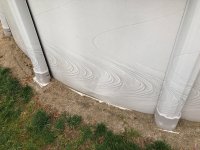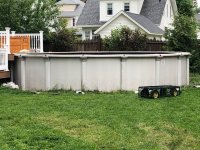I purchased a 24' round pool in 2019 and had a local installer put it in (I am capable, but at the time, my back was giving me grief). He did an awful job so I am full of regret on it. The pool ended up with a visible lean to it; uprights were 3-4" out of plumb. He drained it once and unsuccessfully tried to fix the problem. After that, he gave me a replacement pool and walked away. The replacement has been sitting in boxes in my garage for more than a year because I was not messing with the kids' main source of entertainment during the pandemic.
This spring, I've decided to tackle rebuilding my pool. It was clear to me that the true source of the issue was that the post bases were not level, and were not in a perfect circle. My plan was to empty the pool, fix the level and shape of the wall, and replace the liner since it's already been stretched more than once and is 2 years old at this point. I was hoping to reuse the pool already there and not completely start over (the pool in the garage isn't as nice a model). Unfortunately, one of my helpers got distracted while I was taking the liner down and the pool wall fell inwards - this is what happens when your helpers are under the age of 10. Photo is below.
Photo is below.
So is this wrinkle fatal to the pool? Should I just bang this ding out to flatten it?
What else should I look for as I re-level the post bases? All the tracks appear to be in one piece, but the wall wasn't sitting in the track all the way around.

This spring, I've decided to tackle rebuilding my pool. It was clear to me that the true source of the issue was that the post bases were not level, and were not in a perfect circle. My plan was to empty the pool, fix the level and shape of the wall, and replace the liner since it's already been stretched more than once and is 2 years old at this point. I was hoping to reuse the pool already there and not completely start over (the pool in the garage isn't as nice a model). Unfortunately, one of my helpers got distracted while I was taking the liner down and the pool wall fell inwards - this is what happens when your helpers are under the age of 10.
So is this wrinkle fatal to the pool? Should I just bang this ding out to flatten it?
What else should I look for as I re-level the post bases? All the tracks appear to be in one piece, but the wall wasn't sitting in the track all the way around.



